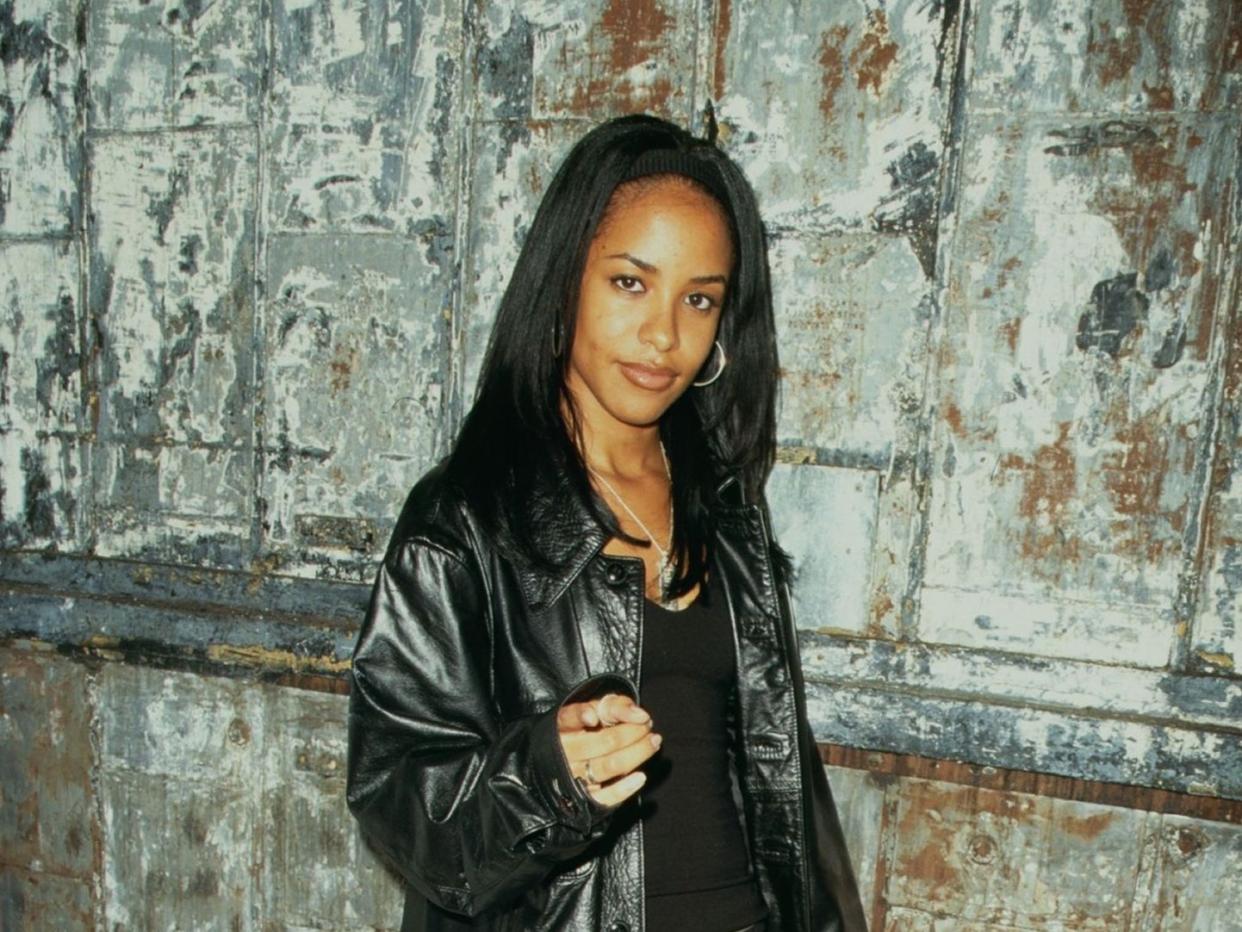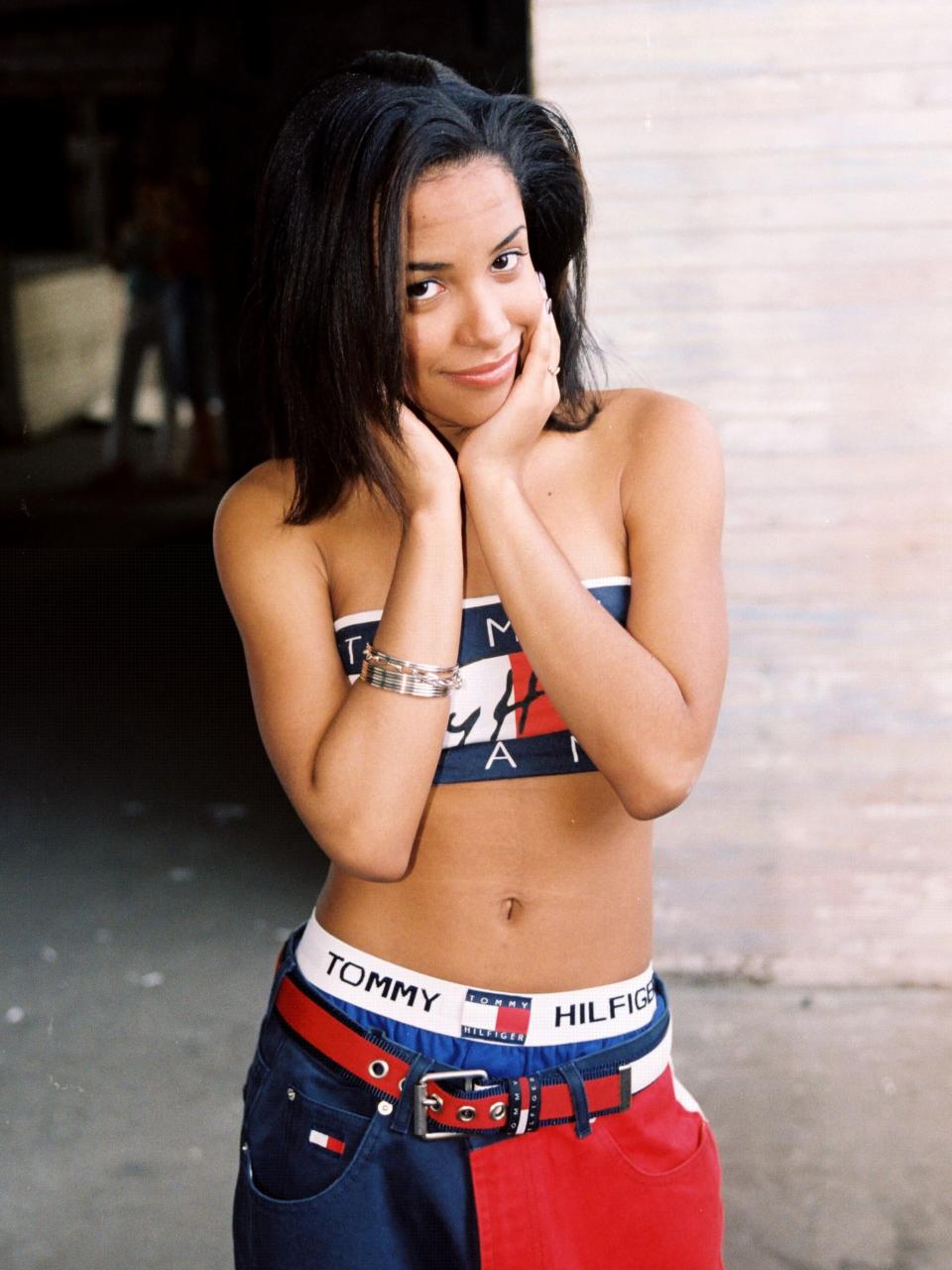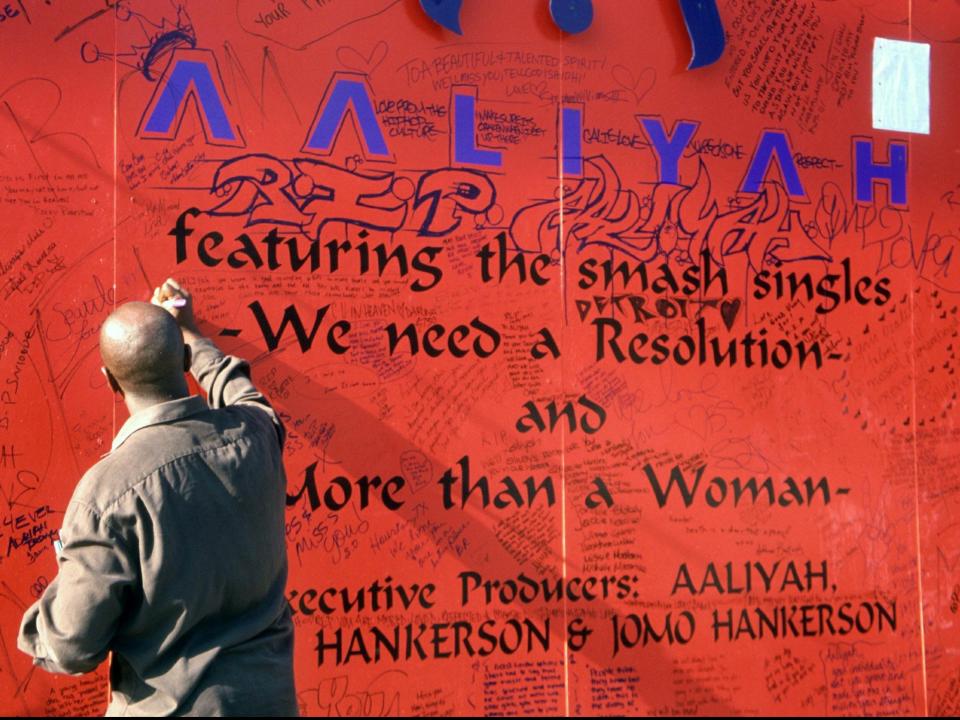‘R&B was never the same’: The life and legacy of Aaliyah

- Oops!Something went wrong.Please try again later.
Kemi Alemoru remembers where she was when news of Aaliyah’s death broke. “I was on holiday in America,” says the culture editor of gal-dem magazine, “and I heard my mum let out this blood-curdling scream.”
“I ran into the other room because I thought my dad might have keeled over,” she continues. “But they had the news on TV – and it said Aaliyah had died. My mum just kept repeating ‘no, no, no!’”
“I must have been about seven, but I knew it was significant.”
It was August 2001, and the R&B singer, mononymously known as Aaliyah, had been on board an overloaded charter plane that had nosedived in the Bahamas, killing her, the pilot and seven members of her team. The artist had released her self-titled album just a month earlier, 20 years ago tomorrow (7 July 2001). She would never see its mammoth global success. Her music would continue to dominate the airwaves long after her death, with Aaliyah going on to top the charts and sell more than 2.6 million copies, its idiosyncratic sound setting the tone for R&B in the early 2000s.
Aaliyah’s passing was felt across generations, though her legacy has an almost otherworldly quality to it. For older fans, her death felt senseless, and the artist became iconised as a trailblazer whose life and career were cut short. For younger fans like me, she was shrouded in mystery, continuing to scoop awards and dominate the R&B charts well into the early 2000s, with “In Loving Memory” tributes tacked on to her posthumously released music videos. She remains widely referenced across hip-hop and R&B, with name-checks in songs by Jay-Z, Noname, Lil Wayne, Kendrick Lamar and J Cole, even though it can feel like her legacy is less widely celebrated than it should be. As Gen-Z YouTuber Julia Boateng asked in a recent video: “Why doesn’t the industry talk about Aaliyah?”
And yet her legacy is a towering one. “Aaliyah is the blueprint,” says R&B singer Paloma Ford, of how the star’s career was something that artists would attempt to emulate for years after her death. Ford is among the countless number of singers – including Beyoncé, Rihanna and James Blake – who credit Aaliyah with having a formative influence on their work. “She’s still unmatched… The way she approached her records with her soft voice and confident lyrics is a major influence on my artistry.”
That delicate vocal is one of the standout aspects of Aaliyah’s short but influential career. The princess of R&B had already had an impressive career that spanned the entirety of the 1990s by the age of 22, having made her debut at 10 on a televised talent show called Star Search. She then made her debut in 1994 with Age Ain’t Nothing But a Number, produced by her mentor R Kelly. But it was the follow-up album two years later, One In a Million, signed to Atlantic, that truly marked Aaliyah out as a star with a unique take on R&B. It had a bold, expansive vision, with tracks effortlessly bouncing from trip-hop to sensual slow jams to jungle beats – proof, if any was needed, that producers Timbaland and Missy Elliott were a dynamite team.
When Aaliyah arrived five years later, again produced by Timbaland, it was an era of new jack swing rhythm, gangsta rap cool and belting soul ballads. But the album combined all of these elements and blasted it into the future. The title track’s soulful vocals were underpinned by a warped, metallic, avant-garde production that would not hit the mainstream for years to come. Tara Joshi, co-host of the pop culture podcast Twenty Twenty, says: “No one else was really making music like that at that time. It aligns her with Janet Jackson – there’s this real sensuality, and a channelling of old and new in this really interesting way.”
Joshi says that it was around this period that Aaliyah began to take more creative gambles – echoing her nickname “baby girl”, her 1998 single Are You That Somebody, heavily features a cooing baby sample from an obscure compilation of sound effects. It might not seem exactly groundbreaking in 2021, but in the mid-Nineties, even as hip-hop was splicing old records in new and inventive ways, this more avant-garde style of found sound was relatively unusual. Here, Aaliyah and Timbaland were intentionally sneaking something weird and provocative into a mainstream pop package. And these risks were always contrasted against Aaliyah’s effortless, pared back, low-register vocals, which stood out amid a sea of vocal runs, as popularised by the likes of Mariah Carey, Christina Aguilera and Alicia Keys.
Kathy Iandoli, author of the forthcoming biography Baby Girl: Better Known as Aaliyah, says that by the time the singer came to her magnum opus, she was also more assertive in the writing and production process. It was echoed by the strikingly self-assured cover image of the singer in a glittering gold halterneck top, rather than hiding behind her signature sunglasses. “With her debut, she was hiding in this very big shadow of R Kelly’s, where her identity on the project was dictated by his own twisted idea of what her image and sound should be,” she says. “With the second album, we saw her inching into her own person, thanks to Timbaland and Missy kind of guiding her in this direction where they threw caution to the wind… But by her eponymous third project, we saw Aaliyah in her full form.
“Her voice had changed a bit since she was now an adult… and she was still very willing to take more risks,” Iandoli continues. “By her final project, it had been five years since she released an album, so there was so much room to grow, to analyse the R&B landscape that she herself helped change in ’96, and then to figure out where she both fit and stood out.”
Sonically, the change was evident – as Aaliyah worked creeping classical samples on “We Need a Resolution”, wild rock electric guitars on “What If”, and other sounds that were atypical for the genre. Even at her most poppy, “More Than a Woman” includes smooth and sweet self-harmonisation amid dark, minor-key strings – it’s enchanting, has a dangerous, addictive quality, and could slot easily alongside a Shakira, Nelly Furtado or Beyoncé track from the middle of the decade. Belting no more, Aaliyah’s voice dances above tinkling piano keys on “It’s Whatever” – with an angelic ease, says Joshi, that’s comparable to anything contemporary by Solange.
“On self-titled, there are things there that Solange will take later on – like the use of self-harmonisation on ‘More Than a Woman’,” agrees Joshi. At the time, however, Aaliyah’s production was truly out on its own. “I think the sonics of it are a little bit strange, and a bit ethereal almost. There’s a futurism that undercuts it all… and this album comes a couple of years before that sound becomes the pop mainstream. Timbaland and Missy both stepped into the mainstream in the early 2000s, but that’s all after this album. So it did shape what happens next, in a huge way… She was the moment. I know that’s a cheesy thing to say, but I think it’s true.”
She was the moment. I know that’s a cheesy thing to say, but I think it’s true
Tara Joshi
In the years following, beat-driven R&B became the standard, with artists like Destiny’s Child, Amerie, Ashanti and Cassie picking up the baton. After setting a standard for a more stoic R&B singer, you could also hear the influence of Aaliyah’s pared-back vocal phrasing in artists like Rihanna and Ciara. Drake also cited her vocal sensitivity as his biggest influence, and he even sports an Aaliyah tattoo: "She conveyed these amazing emotions but never got too sappy,” he has said.
Today, Iandoli says she sees the spirit of Aaliyah everywhere, from the music of SZA to the Swedish pop singer Tove Lo, as well as in the popularity of emerging genres such as alternative R&B. Shortly after the star’s death, journalist Kelefa Sanneh had pointed out that “many of [Aaliyah’s] songs weren’t really songs at all, but simple vocal riffs, repeated and refracted to echo the manipulated loops that create digital rhythm”, many of which have been lifted and sampled more than 320 times across the genres.
Aaliyah wasn’t just influential in music. Paloma Ford points out that by the time Aaliyah died in 2001, her name had become synonymous with a style, a feel and an era, with her tomboyish sports jerseys, low-rise jeans, body chains, crop tops and slinky gowns having come back into fashion in the past two years (under the label Y2K). Vogue’s fashion editor Janelle Okwodu has described Aaliyah as “a bona fide muse for designers who cite hip-hop and the early ’00s as a reference point… There doesn’t seem to be a current streetwear trend that Aaliyah didn’t sport first – something to remember the next time you see someone stepping out in Timb[erland]s and overalls.”
At the time, Aaliyah became a spokesperson for Tommy Hilfiger in 1997, and the baggy red, white and blue jeans she wore in an ad for the brand sold out. The same year, she branched out into acting, playing herself in the police drama television series New York Undercover, landing a lead role opposite Jet Li in Romeo Must Die, filming vampire flick Queen of the Damned and, before her death, being lined up for a role in The Matrix Reloaded. Ford tells me: “She accomplished so much beyond music with fashion and movies, all by the age of 22.”

The jack-of-all trades celebrity is a familiar concept today, but Joshi says this wasn’t the typical career trajectory for a singer in the Nineties. “In many ways, she was the prototype. Looking broadly at her body of work, there are a lot of parallels with what Beyoncé’s career is now,” she says, pointing towards the fact that, like Beyoncé, Aaliyah made her debut as a child on a talent show, continued to work through her teens, and tried her hand at acting (and, unlike Knowles, was met with widely positive reviews). Of course, we all know what Beyoncé went on to achieve, so it’s hard not to imagine a parallel timeline in which Aaliyah might have been the paradigm-shifting mononymous R&B star that changed the industry across a number of decades. In a sense, Aaliyah walked so Beyoncé could run.
Even though her memory is kept alive by present-day goliaths and old-school fans, it can sometimes feel as though we don’t talk about Aaliyah enough – or as if an elevated idea of the singer overshadows the tangible contribution she made to the R&B landscape. Iandoli says: “For the [forthcoming] generation of fans, Aaliyah has been idealised in a way as this mythical figure who lives on through video clips and photos. Because she was just so ahead of her time, it almost brings her up to date in her presence through this multimedia, since she never really comes across as dated. It’s bizarre, really, but also a testament to the fact that Aaliyah was a visionary.”
Joshi adds that Aaliyah’s scarcity on Spotify and Apple Music adds to the star’s legendary, out-of-reach image. Her first album is freely available, but the context surrounding R Kelly – who, following their illegal marriage, has since been the subject of numerous allegations of abuse – means that a dark shadow is cast over the album for many fans. It’s both uncomfortable to listen to and to think about.
Neither of her subsequent albums, which are owned by Aaliyah’s uncle and former manager Barry Hankerson, are available online (beyond low-quality YouTube uploads). “In recent years I’ve been trying to get a vinyl copy of Aaliyah but it’s hundreds of pounds,” Joshi tells me. “It’s interesting, because it means she’s become somewhat intangible – someone whose legacy hovers over everything.”

When it comes to the streaming barrier, Iandoli agrees: “I think [this] has led to many fans creating their own versions of Aaliyah, in a sense. They take fragments of her and magnify them as her whole, when really she was the sum of these parts.”
Then of course, there is the role that death, particularly at a young age, can play in elevating musicians to iconic status. Aaliyah’s life was cut tragically short, and so there will always be a question mark that surrounds what she might have done after her 2001 masterpiece. And as the decades roll on, trends shift and also begin to come back around, constantly providing fresh contexts in which we can situate Aaliyah, her work and her style. Iandoli says that, in this sense, Aaliyah’s death left her legacy “open-ended and in a constant state of flux”.
On the other hand, her death means that some elements of the story are fixed and immutable. “Because Aaliyah passed at 22 years old, she’s for ever young,” Iandoli continues. “She didn’t age, so younger fans latch on to her as she’s frozen in time. I’m not sure that if she were a 42-year-old recording artist today, had she had a fourth, fifth, sixth, tenth album, that a 13-year-old would decide they were a fan of hers,” she says.
“Who knows, though. Aaliyah was so different and so dynamic that maybe she would have galvanised fans of all ages if she were still alive – like she’s doing from above.”
Read More
Jay-Z’s Reasonable Doubt at 25: A glamorous, gritty portrait of unrelenting grind
Reborn on the Fourth of July: Lana Del Rey’s patriot games
Louis Armstrong: the warmth and wit of the legendary jazz artist

